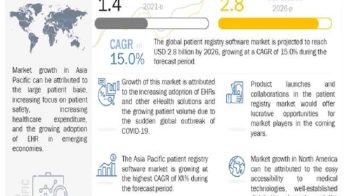The global eHealth market size is projected to reach USD 193.8 billion by 2025 from USD 69.5 billion in 2020, at a CAGR of 22.8% during the forecast period. Factors such as the increased adoption of eHealth solutions, rising elderly population base, and the growing number of infectious diseases are expected to drive the growth of the eHealth market.
Players in the global eHealth industry include Cerner (US), McKesson (US), Philips Healthcare (Netherlands), GE Healthcare (US), and Allscripts (US). Other leading players in this market include athenahealth (US), Epic Systems (US), IBM (US), Optum (US), Siemens Healthineers (Germany), Medtronic (Ireland), and Cisco Systems (US).. These players are focusing on increasing their presence in high-growth markets through both organic as well as inorganic growth strategies, including service launches, expansions, collaborations, and partnerships.
To know about the assumptions considered for the study download the pdf brochure: https://www.marketsandmarkets.com/pdfdownloadNew.asp?id=11513143
GE Healthcare (US) held significant poistion in the global eHealth market in 2019. GE Healthcare is a leading provider of eHealth solutions. It has a strong and robust product and service portfolio of EHR and EMR solutions and services; PACS and VNA solutions; and health information exchange solutions. The company concentrates on R&D activities. It focuses on developing new and improved products and services. GE Healthcare has launched 25 new products, services, and digital solutions in the market. Such initiatives undertaken by the company provide it a competitive edge over other players operating in the eHealth market and help it maintain its foothold in the market.
Cerner (US) also accounted for considerable market share in eHealth market in 2019. Cerner has a robust eHealth solutions portfolio tailored for medium- and large-sized healthcare enterprises to help them with advanced software and services, designed specifically to cater to their requirements. The key strength of the company is its wide geographic presence and extensive distribution network across leading markets. Cerner has a strong global presence. Approximately 88.0% of its revenue is generated from North America. However, the company is focusing on expanding its operations in non-US markets, along with entering new markets through business expansions and the adoption of inorganic growth strategies.
Drivers: Growing need to manage regulatory compliance through the use of eHealth solutions
Over the years, there have been several advancements in the field of healthcare IT, which, in turn, have transformed various eHealth solutions and services into successful and profitable alternatives to manual methods for managing complicated tasks. Healthcare IT systems provide several benefits and capabilities for fulfilling stringent regulatory requirements and handling compliance risks. The changing regulatory requirements in the healthcare industry are resulting in a paradigm shift in the eHealth market. As eHealth tools are an effective way to achieve the required quality goals while reducing costs, their demand is expected to increase among various stakeholders in the coming years.
In the US, the Patient Protection and Affordable Care Act has led to the restructuring of private insurance, Medicare, and Medicaid programs. As a part of these changes, the Meaningful Use rules of the American Recovery and Reinvestment Act (ARRA) and the Health Information Technology for Economic and Clinical Health Act (HITECH) have mandated the adoption of EMRs to increase data interoperability. This has increased the demand for various healthcare IT solutions within healthcare organisations in the US. Moreover, the Medicare Access and CHIP Reauthorization Act (MACRA) established the merit-based incentive payment system (MIPS), which combined the existing Medicare quality programs. These programmes include the Physician Quality Reporting Program (PQRS), the Value-Based Payment Modifier, and the Medicare EHR Incentive Program. MIPS scoring is based on four performance categories: quality, resource use, clinical practise improvement activities, and meaningful use of certified EHR technology. The utilisation of different eHealth solutions by physicians helps them improve their performance and earn rewards through various payment models under MIPS.
Opportunities: Rising use of eHealth solutions in outpatient care facilities
In response to the rising pressures on health systems to lower the cost of care, a majority of healthcare organisations are focusing on introducing specialised outpatient services. The shift toward an outpatient care model is boosting the adoption of eHealth solutions, as these solutions provide a convenient way of delivering carecialized outpatient services. The shift toward an outpatient care model is boosting the adoption of eHealth solutions, as these solutions provide a convenient way of delivering care. These solutions provide easier access to appointments and integration among care providers for a holistic response to care delivery. In addition, these solutions help physicians address patient needs (for access) and allow for remote monitoring of the patient’s health. Owing to the benefits of eHealth solutions, various federal bodies are also supporting the deployment of eHealth solutions in outpatient care settings. For instance, the Government of New South Wales (NSW), through its Community Health and Outpatient Care program, is still operational as a part of the eHealth Strategy for NSW Health: 2016–2026, which focuses on implementing EMR solutions in outpatient care facilities operating throughout NSW. This has boosted the adoption of eHealth solutions among stakeholders in outpatient care facilities to deliver better health services and help enhance patient outcomes. Furthermore, with the benefits of web-based management for constant care, a large number of patients are now moving toward outpatient care needs. For instance, as per a press release by Crain Communications in November 2015, outpatient volume at Flint-based McLaren Health Care Corporation increased to 57% in 2015 from 43% in 2014; this figure is projected to grow to 60% by 2020.
Related News:


